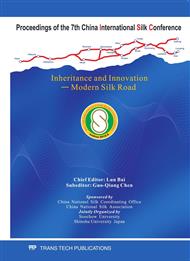p.79
p.85
p.90
p.95
p.100
p.105
p.110
p.116
p.121
Effect of Silk Fibroin on the Properties of Calcium Phosphate Cement
Abstract:
To improve the physicochemical properties of calcium phosphate cement (CPC), silk fibroin (SF) in the different forms were added into CPC. The structure of the composites was studied by X-ray diffraction. The setting time was investigated by ISO Cement Standard Consistency Instrument. Scanning Electron Microscope was used to observe the surface morphology. Mechanical properties of samples were tested by Instron Universal Testing Machine. The results indicated that acicular crystal of hydroxyapatite (HA) was formed in the hardening body of both CPC with SF and the pure CPC. Addition of SF had no significant effect on the structure of SF/CPC composite. The setting time of CPC with SF was significantly shorter than that of the pure CPC (30.3 mins). The setting time of CPC by adding silk fibroin powder I (SFP) and silk fibroin fiber (SFF) was greatly shortened, which was only 11.7 minutes. The setting time of CPC with SFP decreased approximately by 1/3, while the setting time of the CPC with SFF decreased nearly by 1/2. With the adding of SF, the compressive strength of CPC increased significantly. There was a distinct increase in the work-of-compressive of CPC with the adding of SFF.
Info:
Periodical:
Pages:
100-104
Citation:
Online since:
January 2011
Authors:
Price:
Сopyright:
© 2011 Trans Tech Publications Ltd. All Rights Reserved
Share:
Citation:


